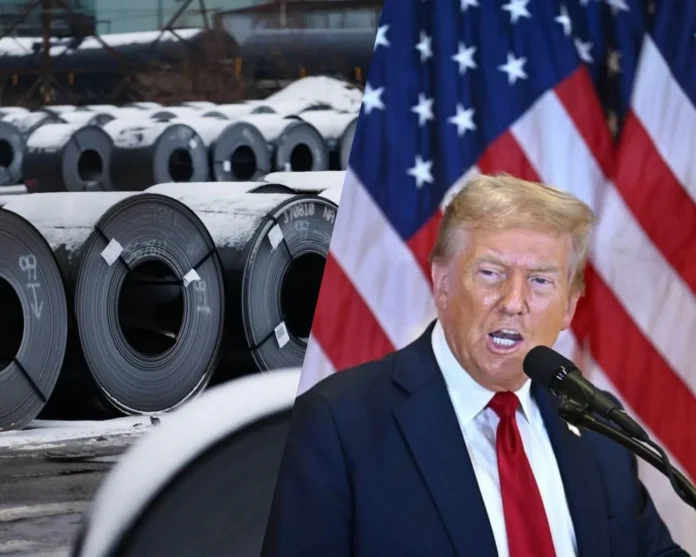Introduction
Trump Tariffs have sent shockwaves through the global financial markets, triggering mixed reactions across Asian stock exchanges. The announcement of 25% tariffs on steel and aluminum imports has investors bracing for potential economic turbulence. With the global economy already facing significant challenges, this move has raised concerns among international businesses and policymakers about long-term economic stability.
Market Reactions: A Mixed Bag
While global stocks initially rallied on Monday, Asian markets showed lackluster performance a day later.
- Hong Kong’s market fluctuated between gains and losses.
- Shanghai and Singapore closed lower.
- Seoul, Sydney, and Taipei recorded moderate gains.
Market analysts suggest that investors are struggling to predict the long-term impact of these tariffs. Some believe that the U.S. protectionist stance could backfire by leading to retaliatory tariffs from trading partners, while others argue that it could benefit domestic industries at the expense of foreign manufacturers.
This uncertainty has also driven gold prices to record highs, reinforcing its status as a safe-haven asset. Safe-haven investments like gold tend to thrive in volatile economic conditions, as investors seek stability amid uncertain policy shifts.
Gold Surges Amid Trade Uncertainty
Investors turned to gold, pushing it to an all-time high of $2,938 per ounce. Safe-haven assets typically thrive in uncertain economic climates, and this trend reflects growing concerns over the broader implications of Trump Tariffs.
“This is still very early days,” said Marc Chandler, Chief Market Strategist at Bannockburn Global Forex. “The market’s just sort of chopping around rather than really directional right now.”
Gold’s rise also suggests that inflation fears are mounting. With rising tariffs increasing production costs, businesses may pass these costs on to consumers, leading to higher prices across various sectors.
Why Are Trump’s Tariffs Significant?
Economic Leverage vs. Trade Policy
Trump Tariffs go beyond simple taxation—they serve as a tool for national security, economic leverage, and revenue generation. The expansion of trade actions beyond Canada, Mexico, and China signals a strategic shift toward long-term economic policy rather than short-term trade disputes. Policymakers in the European Union and Asia are evaluating how to respond, with some nations considering new trade alliances to reduce reliance on the U.S. market.
Inflation Fears & Federal Reserve Response
- Increased tariffs, along with tax cuts and deregulation, could fuel inflation.
- The Federal Reserve may be forced to maintain higher interest rates for longer.
- The U.S. dollar strengthened against most currencies in response.
- Rising prices on imported goods could lead to decreased consumer spending and potential slowdowns in key industries such as automotive, construction, and manufacturing.
Stock Market Volatility
- London and Frankfurt stock markets hit record highs on Monday.
- However, global investors remain wary of unpredictable policy shifts.
- According to senior fellow Maurice Obstfeld of the Peterson Institute for International Economics, “the degree of uncertainty about trade policy has basically exploded.”
- The possibility of retaliatory tariffs from other nations could further complicate the economic outlook, potentially harming sectors that rely on international trade.

Additional Implications of Trump’s Tariffs
Impact on Global Trade Partnerships
- Countries affected by the tariffs may explore new trade partnerships to offset losses.
- Regional trade agreements, such as the Comprehensive and Progressive Agreement for Trans-Pacific Partnership (CPTPP), may gain importance.
- China, the EU, and Canada have hinted at potential retaliatory tariffs, which could escalate into a broader trade conflict.
Effects on American Consumers and Businesses
- Production expenses are greater for American companies that depend on imported raw materials.
- Some industries, such as steel manufacturing, may benefit, but downstream industries (e.g., automotive, aerospace) could suffer due to rising material prices.
- Higher tariffs may cause price increases for everyday consumer goods, squeezing household budgets and reducing discretionary spending.
What’s Next for Investors?
Investors will be closely watching consumer and producer price index reports this week for inflation trends. Additionally, Federal Reserve Chair Jerome Powell is set to give testimony before U.S. lawmakers, potentially offering insight into future interest rate adjustments.
Global markets will also monitor how other countries respond. Any indication of retaliatory tariffs from China, the EU, or Canada could lead to increased volatility and heightened economic tensions. If global supply chains are disrupted, companies may seek alternative suppliers, leading to short-term uncertainty and long-term shifts in trade relationships.
Final Thoughts
While the impact of Trump Tariffs is still unfolding, the initial market response has been mixed. The surge in gold prices, heightened inflation concerns, and the strengthening U.S. dollar indicate that investors are preparing for potential long-term economic shifts.
For now, markets remain on edge, awaiting the next White House announcement that could further shape the global economic landscape. With ongoing trade negotiations and the potential for additional tariffs, economic uncertainty remains high. Investors, businesses, and policymakers alike must navigate a rapidly changing financial environment, balancing short-term risks with long-term strategic planning.


